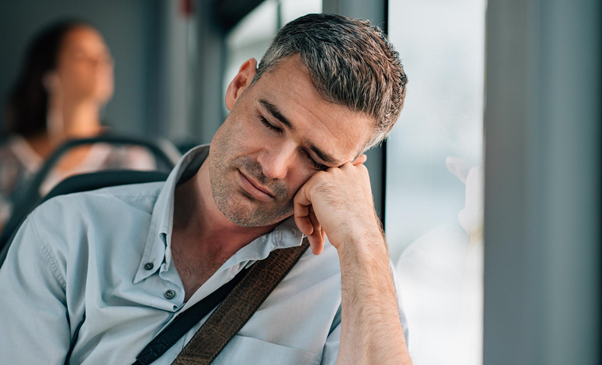Sleep apnoea (or sleep apnea) is a condition which disrupts a person’s normal breathing pattern while asleep, causing them to temporarily cease breathing. Researchers from the University of Melbourne have found that sleep apnoea affects up to one in 10 people, with the likelihood rising as age increases.
According to the heart foundation of America, sleep apnoea is linked to numerous other health problems including high blood pressure, stroke and cardiovascular disease.
Sleep apnoea can be treated through a combination of healthy lifestyle factors and use of medical devices.
What is Sleep Apnoea?
Apnoea can be defined as a temporary cessation of breathing. Medical definition of an apnoea requires that the patient remains at least 10 seconds without breathing before they are classified as having experienced apnoea.
Apnoea can occur when a patient’s airway is blocked during sleep, causing them to momentarily stop breathing. This can occur many times during the night, forcing the patient to awaken and greatly impacting sleep quality. It typically occurs due to one or a combination of the following reasons:
Obstructive Sleep Apnoea (OSA): This type of apnoea is the most common and occurs due to an obstruction of the patient’s airways, impacting breathing during sleep.
Central Sleep Apnoea (CSA): This type of apnoea is less common than OSA and occurs when the brain fails to send the correct signals to the muscles which control breathing.
Signs and Symptoms
The signs and symptoms of sleep apnoea can be difficult for individuals to detect, as they will often occur during sleep. Snoring and obstructed breathing are generally first noticed by partners and may lead to further investigation when paired with noticeable daytime symptoms.
Common symptoms of sleep apnoea can include:
- Excessive daytime sleepiness
- Difficulty waking and rising
- Morning headaches
- Choking feeling during the night
- Falling asleep during the day
If left untreated, continuously disrupted sleep can lead to further health problems including increased risks of cardiovascular disease and stroke.
What Causes Sleep Apnoea?
Obstruction of the airways is the most common reason for sleep apnoea, as opposed to neurological conditions which can cause central sleep apnoea (CSA). Airway obstruction usually occurs due to a collapsing of the patient’s upper airway which can happen for a variety of different reasons.
Common causes can include:
- Nasal congestion and obstruction
- Endocrine disorders
- Facial structure
- Swollen tissue or tonsils
In addition to physical factors, a range of contributing lifestyle factors can also influence and increase the risk of apnoea occurring, including:
- Alcohol
- Smoking
- Drugs and medication
Who’s at Risk?
Certain members of the population are at increased risk of experiencing sleep apnoea due to age and other factors increasing likelihood of obstruction. Factors which are associated with an increased risk of OSA include:
- Gender
- Age
- Neck size
- Weight
- Family medical history
Excess body weight can increase soft tissue around the neck, weighing down a patient’s airways and increase their risk of OSA. Males are also at a statistically higher risk of developing OSA due partly to their physiology and increased size.
The risk of developing OSA also correlates to an increase in age, especially after the age of 40, as the body naturally begins to lose muscle tone.
How is Sleep Apnoea Diagnosed?
Hospital in–lab sleep studies are the best way to diagnose obstructive sleep apnoea, as they are conducted by highly trained sleep scientists and technologists who are formally trained to record and interpret sleep data.
Symptoms such as daytime drowsiness and snoring can be signs that you should consult a medical practitioner and book a sleep study. However, these symptoms are not necessarily conclusive proof of OSA and may be attributable to other causes.
Modern sleep studies can be performed in a sleep lab for best results, or in a patient’s home to maximise comfort and accessibility. It’s important for patients to seek accredited sleep lab facilities that are registered and accredited.
If sleep apnoea is left undiagnosed and untreated, it can place stress on the body and in particular on the heart. This in turn can contribute to cardiovascular disease and increased risk of diabetes and stroke. OSA costs the Australian economy over $7.49 billion each year due to its eventual impact on the healthcare system when left untreated.
How is Sleep Apnoea Treated?
Sleep apnoea can be treated by reducing contributing lifestyle factors and the appropriate use of specialised and personally prescribed medical devices. Depending on the severity and type of sleep apnoea, medical device treatment may or may not be necessary.
Treatment options can include:
Positional therapy: If obstructive sleep apnoea occurs primarily when the patient is sleeping on their back, a wearable device alerting a patient when they need to move and sleep on their side can reduce their likelihood of suffering OSA.
Mandibular devices: OSA can also occur due to the jaw slipping while asleep. A wearable mandibular device can help to keep the patients jaw positioned correctly and reduce the risk or severity of OSA.
Continuous Positive Airway Pressure (CPAP): CPAP devices use a small breathing mask which is worn while asleep and can assist in keeping airways open with a constant stream of pressurised air.
Auto Titration Positive Airway Pressure (APAP): Similar to CPAP, APAP devices have the advantage of being able to monitor resistance in the airways and adapt their air pressure accordingly.
Surgery: Removal of physical obstructions in the patient’s airways and other specific surgical procedures may help to limit OSA frequency or severity. However, the potential complications and risks of undergoing surgery should be taken into consideration.
Before resorting to invasive treatment, patients are always encouraged to make positive changes to their lifestyle risk factors to reduce OSA. Losing weight, quitting smoking and following good sleep hygiene can greatly assist in decreasing the severity of OSA.
While sleep apnoea can lead to serious chronic health problems if left untreated, the range of support options available to patients can help them to manage their diagnosed symptoms and live a healthy and happier quality of life.




